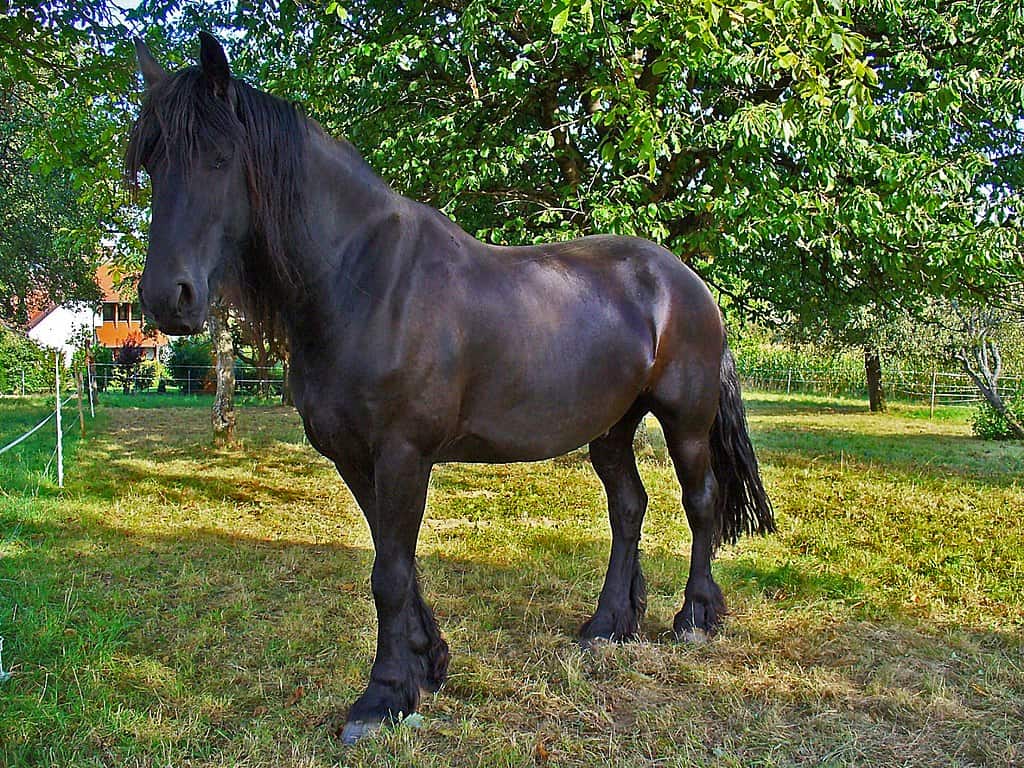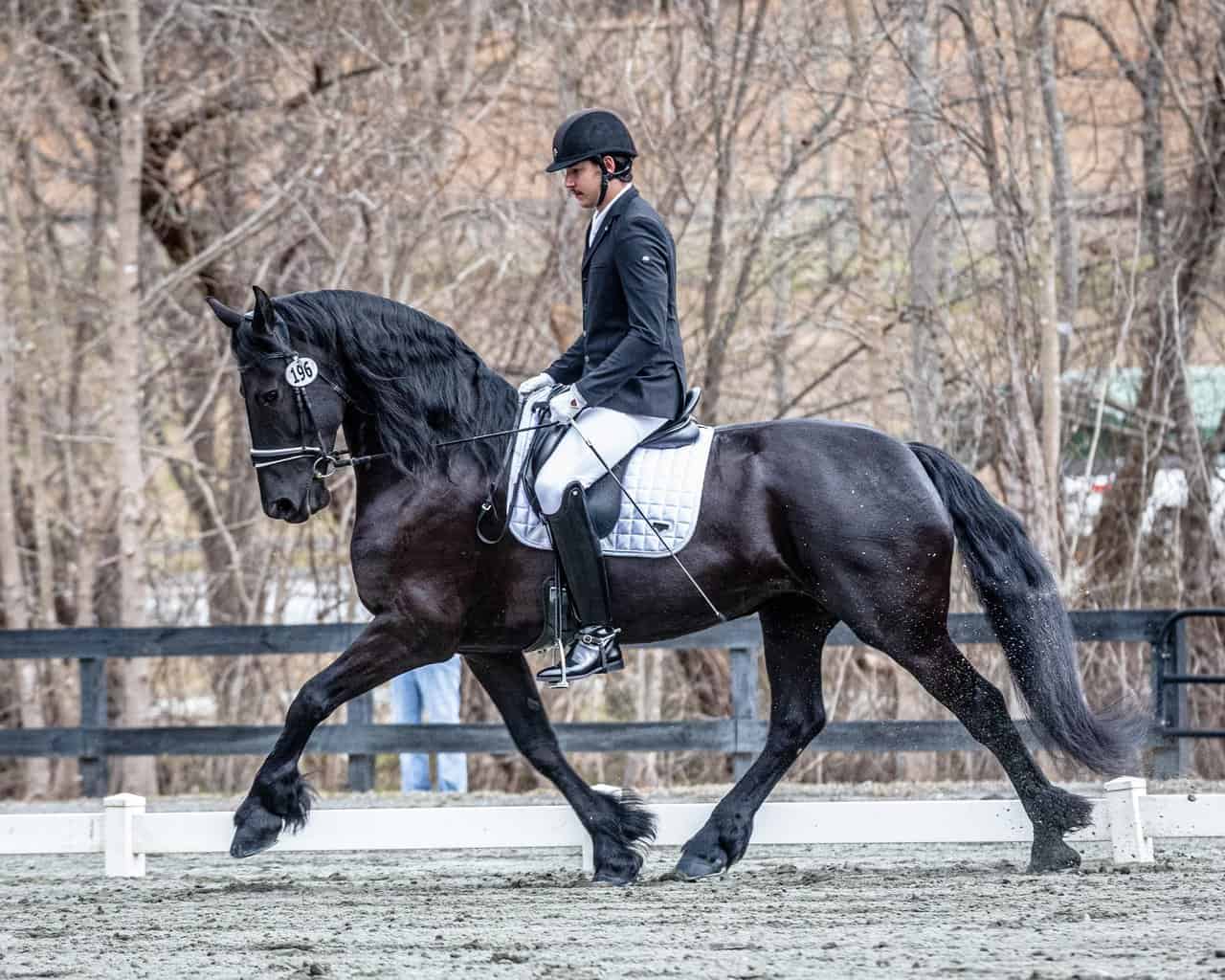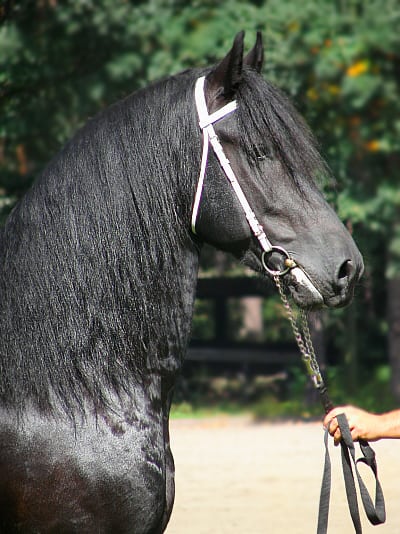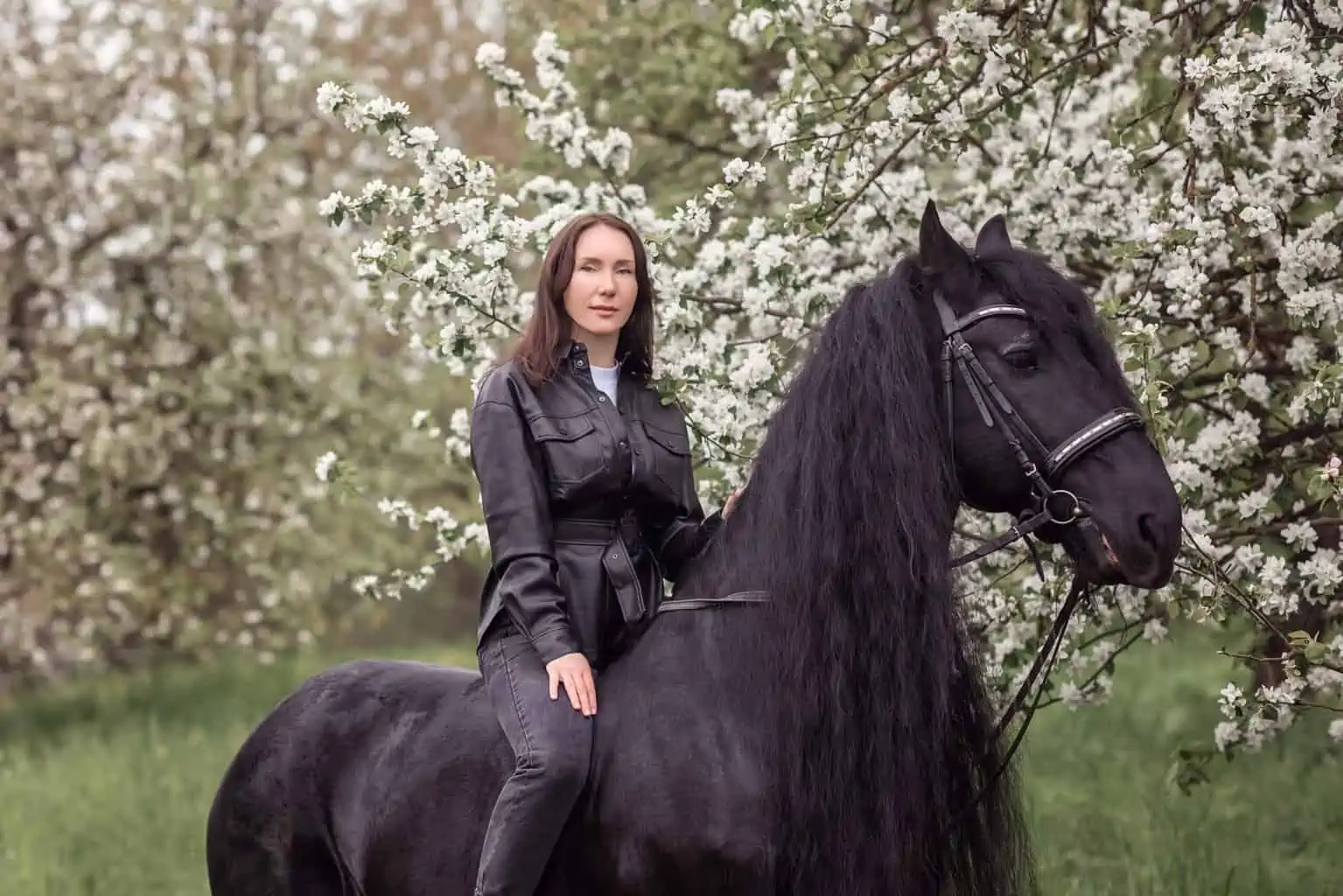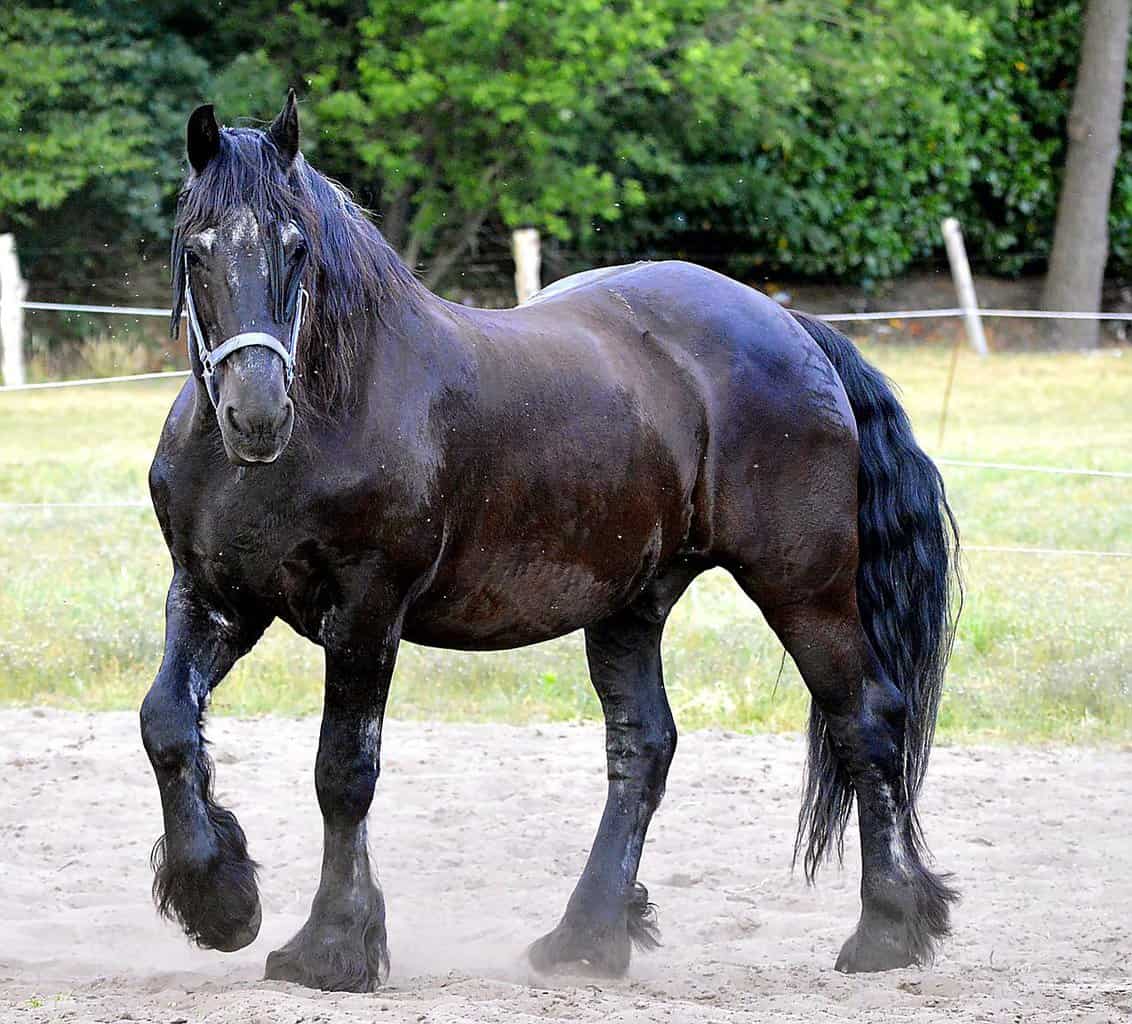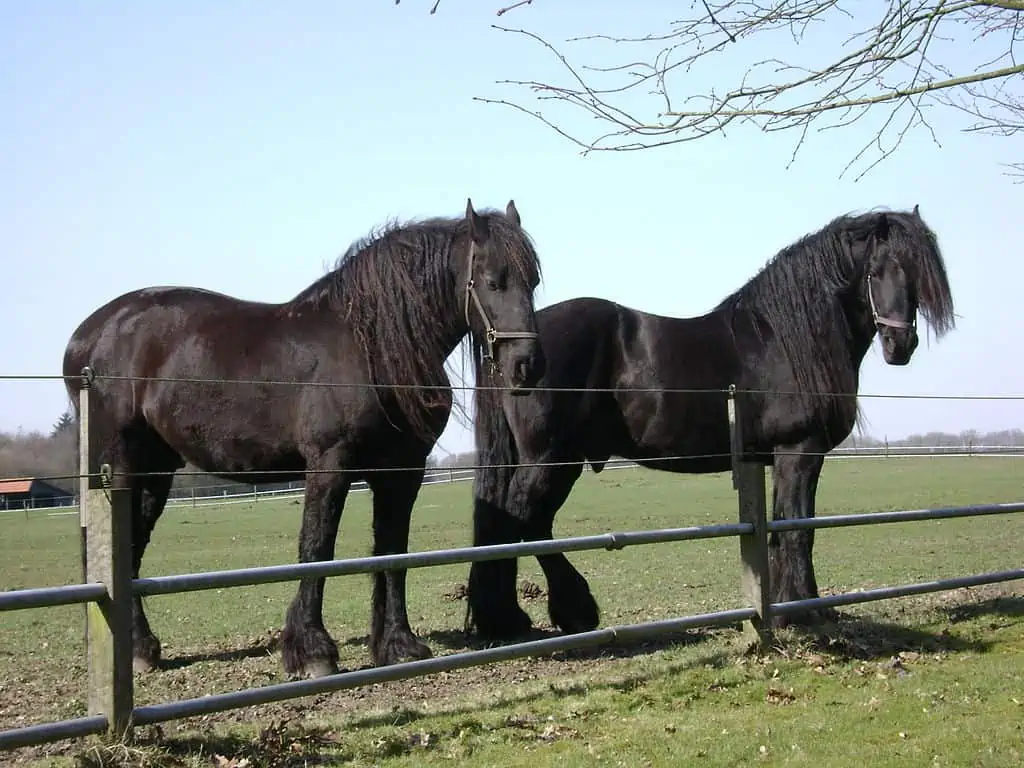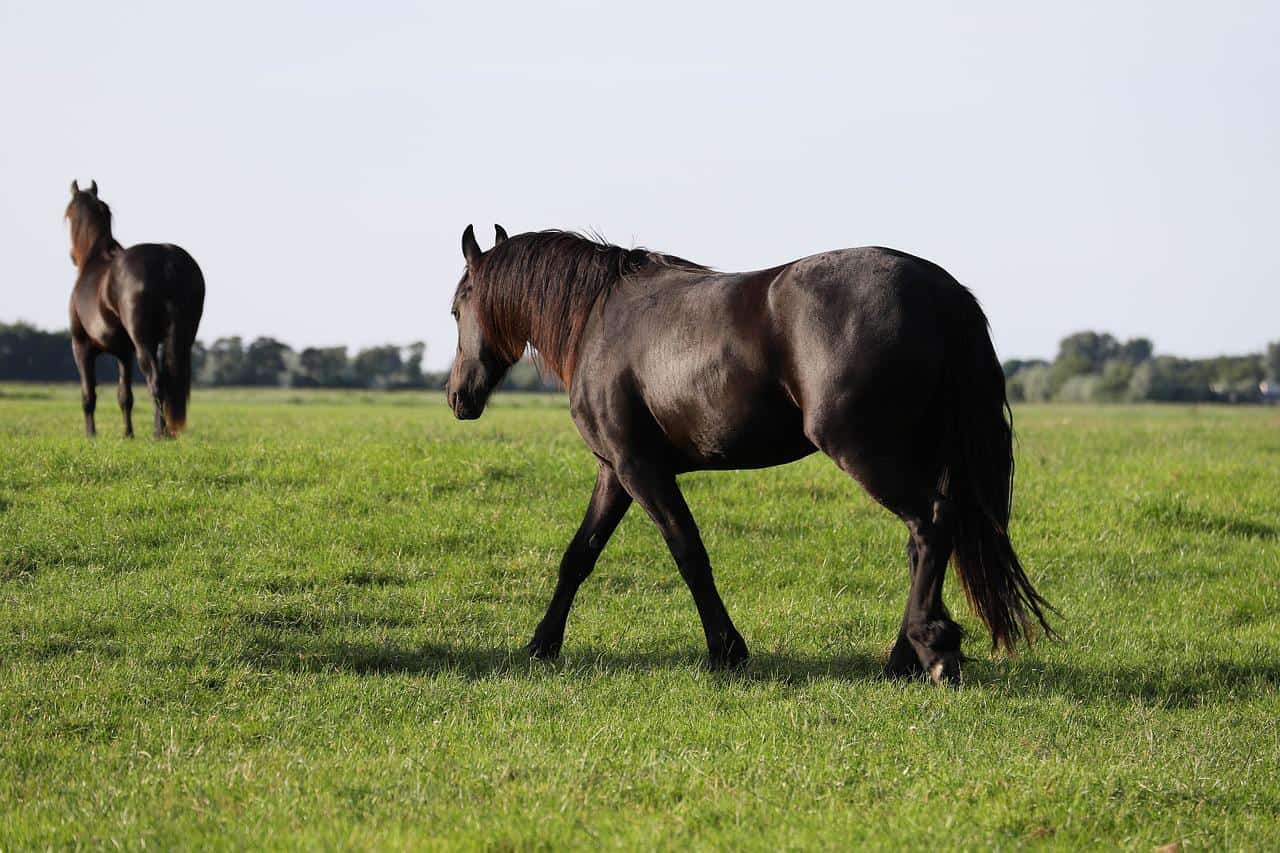- Can Horses Eat Watermelons - September 23, 2023
- How to Get a Horse to Trust You - September 21, 2023
- Best Horse Wormers for Spring Guide - August 10, 2023
- Introduction: Friesian Quick Facts
- Friesian Overview
- How to Identify a Friesian
- Friesian Lifespan
- Friesian Appearance and Varieties
- Friesian Human Interactions and Training
- How to Care for a Friesian
- Friesian Diet
- Breeding Friesians
- Friesian Cost
- Where to Buy a Friesian
- Famous Friesians
- FAQs
- Freisian Horse Guide: Conclusion
- Research Citations
As a breeding assistant on Thoroughbred stud farms, I’ve worked with some of the most expensive horses in the world, but it was the Friesian horse which stole my heart. The first time I saw a Friesian, it was love at first sight. It’s hard not to be captivated by the Frisians’ striking appearance and majestic stance.
These horses aren’t just good looking – they’re also strong, powerful, intelligent, and easy to train. Friesians are one of the most charming members of the equine world, and you can find out all about them below.
Introduction: Friesian Quick Facts
| Species | Equine |
| Horse Family | Draft/Sport |
| Horse Breed | Friesian |
| Common Names | |
| Country of Origin | Netherlands |
| Breed Origin (if cross breed) | |
| Height | 15.3 – 17 hands |
| Weight | 1200 and 1400 lb |
| Color | Black |
| Coat Quality (curly haired, short, thick) | Short and shiny |
| Body Hair (feathered, lush or thin tails/manes) | Long, thick mane and tail with lots of feathers |
| Temperament | Calm and well mannered |
| Lifespan | 15 – 17 years |
| Purpose (racing, work horses, etc.) | Driving, dressage and trail riding |
Friesian Overview
The majestic Friesian horse is from Friesland, a northern province of the Netherlands in Europe. They’re tall horses that measure between 15.3 and 17 hands. Friesian horses are famous for their jet black coat, long black, silk mane and tail, fluffy feathers and elegant gait.
The average weight of a Friesian is between 1200 and 1400. They have the height, frame, and laid back temperament of draft horses but are elegant, agile and athletic. Friesian horses were traditionally used for agriculture and as war horses due to their strength and agility. The striking appearance and size of the Friesian also made them the horse of choice for nobility.
The Friesian horse is a rare breed, and it almost became extinct, so these days, breeding standards are very tight for Friesian horses. In the USA, the governing association for Friesians is the Friesian Horse Association of North America (FHANA).
How to Identify a Friesian
The most defining thing about Friesian horses is their silky, jet black coat, full feathers, and long, thick manes and tails. The mane of a Friesian will usually flow over and past its shoulder. Friesians must be true black – they are not allowed any white markings except for a small star on the forehead.
Friesians are large, big-boned horses, and they usually stand between 15.3 and 17h tall. They have a small head and ears with a powerful, slightly arched neck, well-developed withers, and a strong back.
Friesian horses usually have a wide, slightly downward, muscular croup with wide-set shoulders and a deep chest. Another thing that defines the Friesian is its elegance. Friesians move gracefully with a vigorous, powerful stride.
Friesian Lifespan
Friesian horses generally have a shorter life span than most horses. The average age for a horse is 20 to 25 years, but Friesians have a life expectancy of between 15 and 17 years. Potentially, this is due to the strict breed regulations which have shortened the gene pool.
Not all Friesians die young – many live longer than 17 years. The oldest Friesian on record lived for 34 years, and his name is Drieske Star. The lifespan of a Friesian depends a lot on the horse’s lifestyle, environment and genetic disposition.
If you want to increase the lifespan of a Friesian, choose one that’s not so purebred or a crossbreed. Friesians age faster than most horses and you should treat them as seniors from 10 to 12-years old. This includes giving them senior supplements and ensuring they get a high-quality diet.
Friesian Appearance and Varieties
There are two types of Friesians, the Baroque and the Sport. Sports Friesians are a modern variation of the breed- they have long, unfeathered legs and look more square from the side. Sports Friesians perform well in sports such as dressage and equitation, and it’s common to breed them with warmbloods.
Baroque Friesians are the traditional type of Friesian, with a thick mane, tail and feathers, and high leg action. Baroque Friesians have a typical carriage horse body with short limbs, and they look more rectangular.
Friesians are famous for shiny black coats, but not all Friesians have black coats – some Friesians have chestnut coats – and these are known as Fire Friesians. You can’t register a chestnut Friesian as a standard breeding stallion – instead, they have their own special Fire Friesian studbook. You can sometimes register chestnut geldings and mares as Friesians if they have exceptional conformation. Fire Friesians are rare, with only three official stallions.
Friesian Human Interactions and Training
Friesian horses are gentle giants with a calm, laid back temperament. They’re renowned for being friendly, curious and patient, and they enjoy being around people and other animals.
Friesian horses are quick learners and eager to please, which means they’re easy to train and handle. Friesians are pretty easy-going most of the time but are highly intelligent and quite sensitive – so sometimes they suffer from anxiety.
The Friesian breed is popular because they’re versatile and perform well in many riding disciplines, and they look stunning in the show ring. The only thing the mighty Friesian isn’t good at is jumping because they don’t have the right body shape.
Friesians are fantastic trail horses because they have hard feet, a good pace and a sensible attitude. Friesians aren’t officially “gaited” horses, but they are outstanding trotters, and in the Netherlands, people use them for trotting racing.
The Friesian is elegant and agile with lots of stamina, so they are popular dressage horses, and with their calm nature and tremendous power, they also make excellent driving horses.
Driving has been one of the Friesian’s main occupations over the years. In the Netherlands, they were traditionally used as agricultural horses. In the United Kingdom, Friesian horses have been pulling carts, particularly taxi cabs and hearses, in London since the Victorian times.
Friesian horses have their own carriage called the Friesian Sjees – a unique two-wheeled cart with the driver on the left. Usually, one or two horses will pull the Sjees, but sometimes, there can be four to ten Friesians on one carriage.
Friesians are great “all-rounders” and suit owners who like to enjoy different disciplines. They are also fantastic for people who enjoy driving and dressage or trail riding.
How to Care for a Friesian
Friesians are large horses which means they need larger everything – a larger stable, larger food rations, and they often come with bigger vets bills. Along with basic care, Friesians need more food supplements, and potentially they might need more vet visits too.
Due to strict breed standards, most Friesians have a small gene pool. So, just like with all pedigree animals, they’re more susceptible to certain illnesses, genetic disorders and diseases. Friesians, in particular, are renowned for having skin problems. Many suffer from chronic dermatitis, insect bite sensitivity and skin allergies – which are hard to treat and manage. Some Friesians also suffer from Anhidrosis – an inability to sweat properly.
Friesians tend to have a weaker immune system, and they’re susceptible to dwarfism, an inherited disease. They’re also more prone to PSSM – a muscle disease, Hydrocephalus, aortic rupture and an enlarged esophagus. Placenta retention is also a problem in Friesian mares – 54 percent retain their placenta.
Friesians are very elegant, so you might be surprised to know that they’re pretty easy horses to keep and are quite hardy. Their toughness is one of the main reasons they were the chosen horse for Victorian London taxis. Friesians can get by on less food and thus produce fewer droppings.
Apart from potential health problems, Friesians are generally easy keepers. However, they’re not as hardy as other draft breeds – so always increase their food rations in winter and give them a blanket in the cold.
Friesian Diet
A Friesian’s diet will depend on several things such as its age, condition and workload. Older horses, young developing horses, pregnant mares and horses in full work will need more food rations than an average Friesian with a light workload. Friesians who need extra calories should eat concentrated cereals and grains – along with forage, as part of their diet. Your Friesian will also benefit from fruits and veggies as an occasional treat.
Friesians are large horses and will benefit from a high-quality joint supplement in their food. You can also add Omega 3 oil to their diet to help with skin problems and promote a shiny coat. Friesians often have a weak immune system, so they will also benefit from a garlic supplement in their diet.
Breeding Friesians
Many draft breeds, including the Friesian, came close to extinction in the early 20th century. The rise of modern farming machinery slowly made agricultural horses redundant. As well as this, in the Netherlands, Friesians were bred with other draft horses to produce Bovenlanders. As a result, the Friesian stud books and bloodlines became heavily diluted, and in 1913, only three official breeding stallions remained in Holland.
During World War Two, the demand for strong warhorses made Friesians popular once again. At the same time, breeding became more regulated, and there is currently a healthy population of Friesians in the Netherlands, where they account for around 7 percent of the horse population.
Friesians are a rare breed of horse, and there are only 8000 registered in the USA. The official Friesian studbook in the Netherlands is known as the “Friesch Paarden Stamboek” or the KFPS, and they have 12000 registered members.
Strict Breed Standards
The Friesian breed almost became extinct, so Friesian associations have strict standards for registering horses. Friesian foals can be registered in different grades of stud books depending on their conformation and bloodline. Before a foal is registered, a member of the local Friesian society will visit to grade it. Not all Friesians are accepted into the studbook, and few stallions make it to the primary studbook.
Foals also need to be DNA tested for two reasons – firstly, the DNA test will confirm their purity and check for the chestnut gene. Secondly, it will reveal genetic diseases and illnesses. Foals who carry genetic diseases or the chestnut gene won’t be registered.
Friesians must be black all over – they can’t have any white markings, except for a small star on their forehead. Friesian mares and geldings must be a minimum of 15.2 hands to be registered.
The Friesian is an ancient breed which has influenced many different horse breeds over the centuries, including the Morgan horse from the USA. In the British isles, the Shire, Hackney, Dales and Fell all have a Friesian heritage, as do The German Oldernburger and Dole Gudbrandsdals from Norway.
Friesian Cost
As well as being stunningly beautiful and versatile, Friesians are a rare breed, so they are one of the more expensive horses on the market. You can expect to pay anywhere between 7,000 and 300,000 dollars for a pedigree Friesian.
The value of a Friesian depends on many things such as its age, gender, athletic capability, conformation and whether or not it’s registered. An unbroken, unregistered yearling will cost a lot less than a fully registered champion breeding stallion, for example.
Friesians have a short lifespan, so Friesians over 10-years old will generally sell for less. The most expensive types of Friesians are fully-registered stallions or broodmares, or champion competition horses.
Where to Buy a Friesian
The best place to find Friesians is in Holland, where they have the highest quality Friesians and more of them to choose from – Friesians are rare in the USA. Importing a horse is expensive, so you should only consider this option if you have a large budget.
If you want to buy a Friesian in the USA, look for trusted and well-reputed breeders and stud farms. A good place to start your search with The Friesian Association of North America and the Friesian Horse Society. You can also look on horse forums and marketplaces on the internet to find your perfect Friesian or get in touch with local horse dealers.
When you buy a Friesian, remember it must be all black, with no white markings, except for a small star. If you want a purebred make sure the horse is KFPS registered, and always make sure it comes with a passport and official papers.
Famous Friesians
Friesian horses are stunning, so it’s no surprise they’re the most popular breed in Hollywood. Friesians look even more amazing on the big screen and are often featured in blockbusting movies. Movies such as The Mask of Zorro, The Chronicles of Narnia, 300, Sense and Sensibility, and the popular TV series, Game of Thrones feature Friesians.
A Friesian stallion called Fredrik the great holds the title of being the most beautiful horse in the world. Fredrik was born in the Netherlands and imported to the USA when he was six years old. He’s got a mane and tail to die for with a glistening jet black coat, and he moves like a graceful movie star. Fredrik and his owner like to practice dressage when they’re not showing off for the cameras.
FAQs
Answer: Friesians have a calm, laidback, gentle attitude, so they are a fantastic horse for beginners, as long as they’re confident handling a large horse. The Friesian’s size can intimidate novice riders. Always choose a mature, well-trained Friesian if you’re a beginner – it’s never a good idea for a beginner rider to start with an inexperienced horse.
Friesians are pretty easy to keep which also makes them excellent for beginners. However, it may take a more experienced owner to deal with the potential health problems associated with Friesians.
Answer: Friesian horses are a pleasure to train – they’re very cooperative horses, and eager to please. Friesians are very adaptable and excel in many riding disciplines, such as driving, trail riding and dressage. Friesians are placid by nature, but they can be athletic and forward going under the saddle.
Answer: As a rule, a horse needs at least 1 to 1.5 acres of land to graze on. However, Friesians are large horses, and they may need more space depending on their size. Also, horses are herd animals, so you should never keep a horse alone, so you should have room for at least two horses. If you only have the minimum amount of land and your horse grazes it all year round, you must supplement its diet with forage.
Answer: Friesians are late to mature both mentally and physically, and it can take them up to 8 years to fully develop, so most owners won’t start riding Friesians until they are at least 4-years old. Many owners even wait until their horse is 6-years old before they ride them. If you ride a Friesian before it’s fully developed, this can harm their health and development.
Always start Friesians off slowly, and if you want to train them before 4-years old – stick to groundwork such as long lining to prepare your horse for riding.
Freisian Horse Guide: Conclusion
If you’re looking for a fantastic all-round horse, look no further than the Friesian. These horses are strong and adaptable, with the power and stature of a draft breed but the grace and stamina of a sports horse.
Friesians have a delightful personality – they’re gentle, laid-back and eager to please, so they’re a good horse for beginner, and experienced riders. The only drawback to the Friesian is its price tag. It’s a rare breed with strict breed standards, and a purebred can set you back tens of thousands of dollars.
Read More:
- Haflinger Horse Guide: All The Things You Need to Know
- Blue Roan Horse Guide
- Arabian Horse Guide
- Fastest Horses of All Time: The Top 5
- Bay Horse Guide
- American Quarter Horse Guide: Everything You Need To Know About Them
- Buckskin Horse Guide
- Andalusian Horse Guide
- Shire Horse Guide
- Stallion Horse Guide
====


